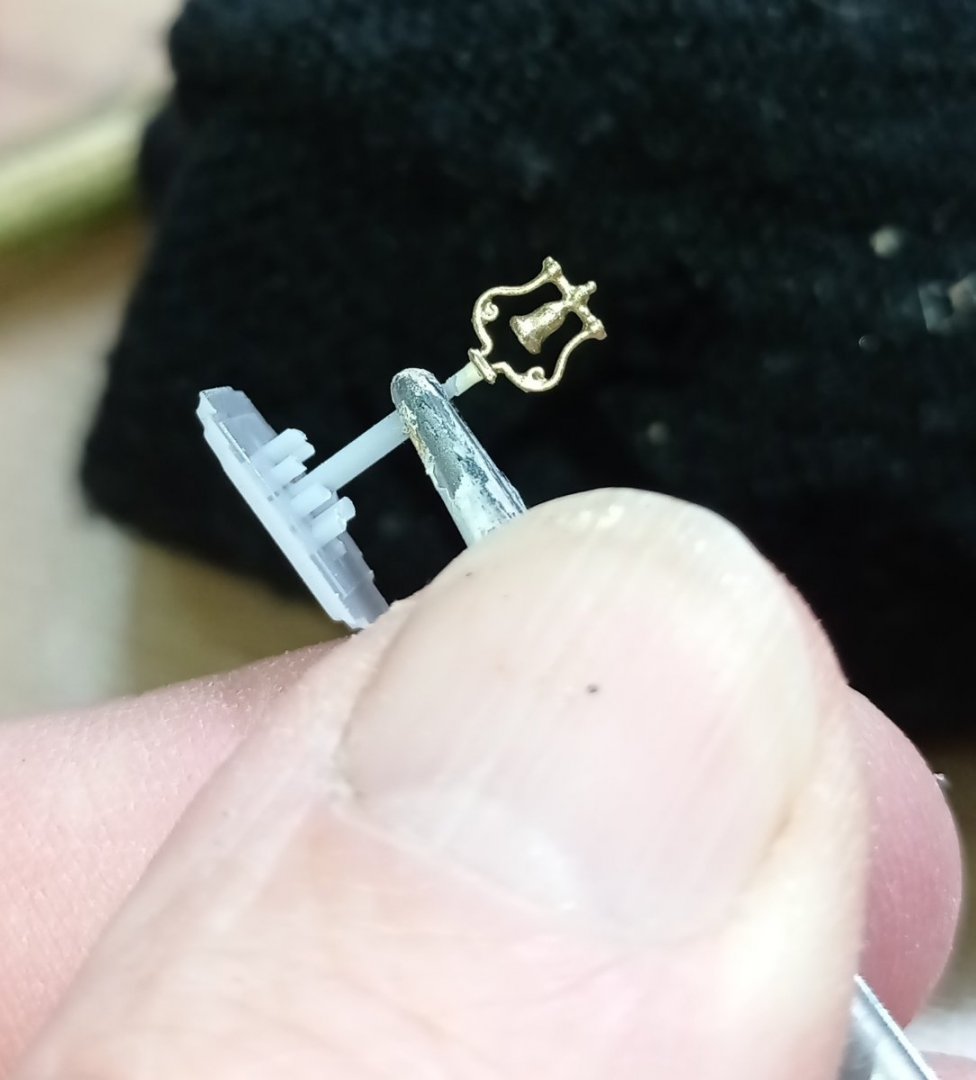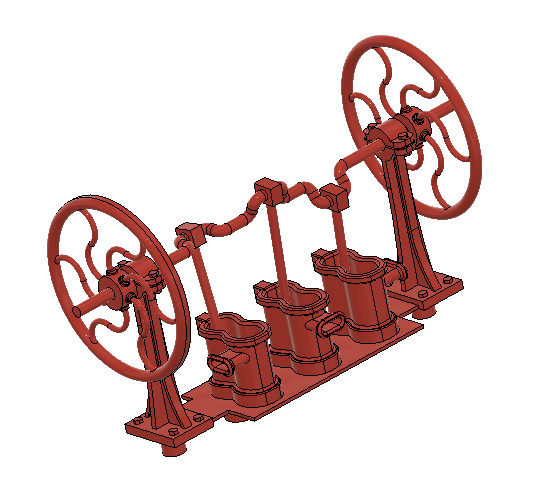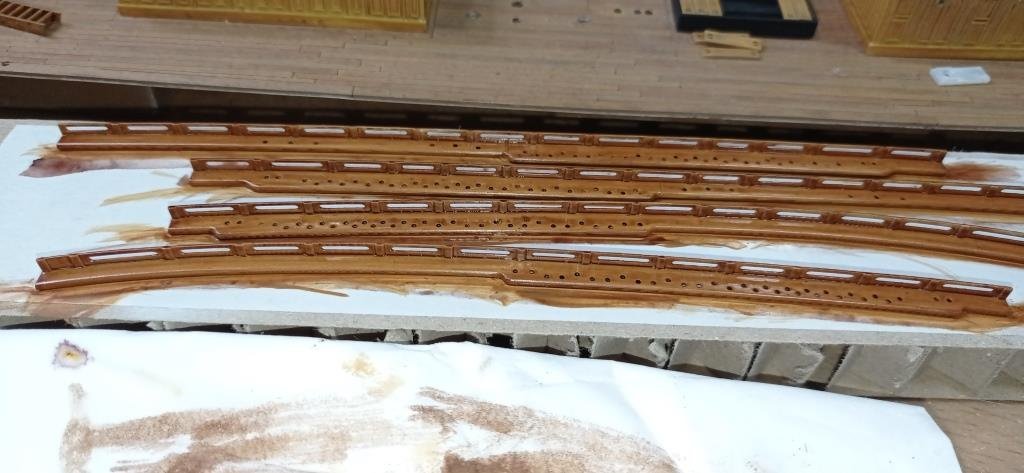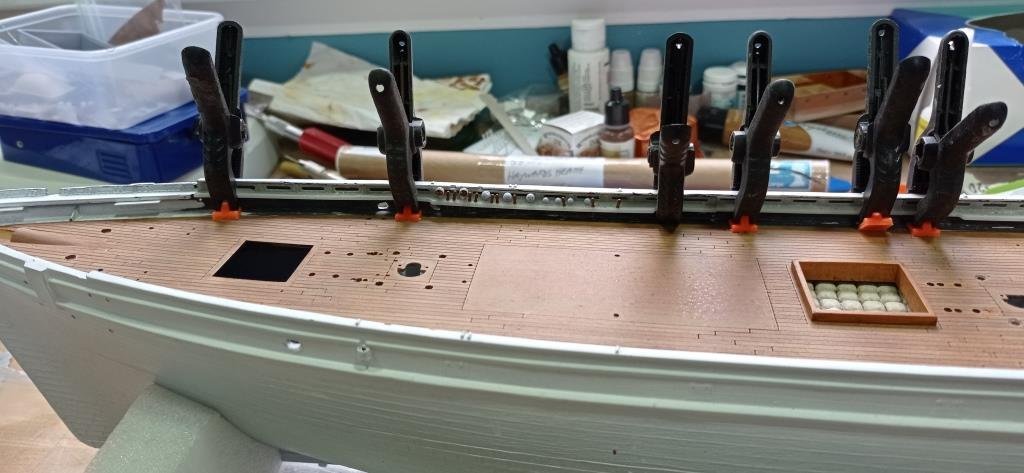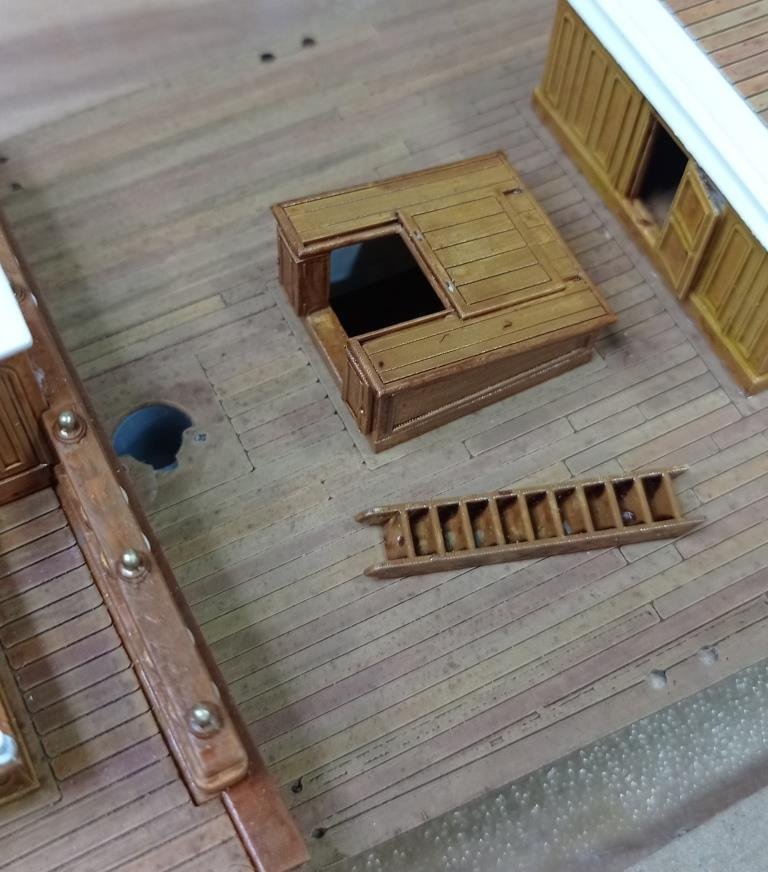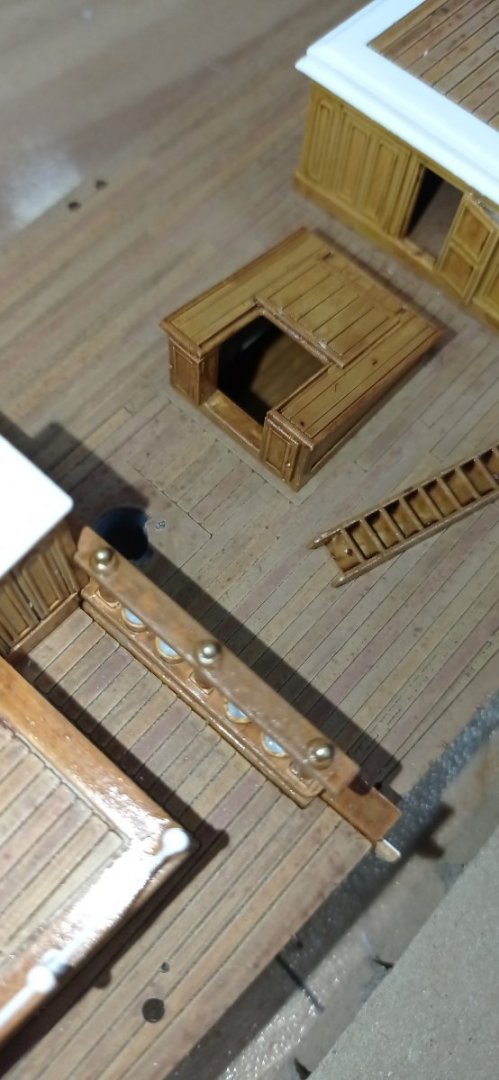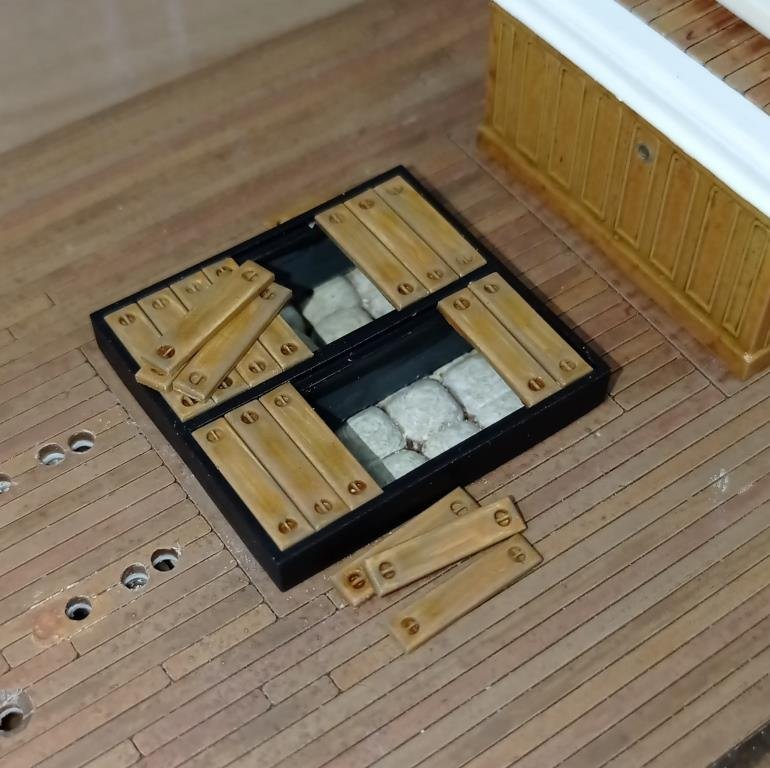-
Posts
1,215 -
Joined
-
Last visited
Content Type
Profiles
Forums
Gallery
Events
Everything posted by Kevin-the-lubber
-
A question now - this metallic black paint is all very well but it does make things look like they've just been unloaded off the factory lorry. How do I make them look a little more aged... weathered I guess? (The gold stays as it is, hands off my shiny bits 🤪)
- 444 replies
-
- Cutty Sark
- Revell
-
(and 2 more)
Tagged with:
-
Rob, you would have an absolute blast if this was your thing. But I have a feeling you might not find it very satisfying. I look at your work on the Glory, Bruma's yards, Dafi's Victory, Marc's Soliel, and countless others, and wish I had those skills. However, it's not a bad way to learn stuff or try things out. And for those of us who make mistakes at every turn while we're learning, it's heaven. Stuffed it up (yet again)? No prob, just print another. You should see my scrap bin, especially last year's.
- 444 replies
-
- Cutty Sark
- Revell
-
(and 2 more)
Tagged with:
-
There won't be that much more detailing, I think. I am on a bit of a roll though, it's like 18 months of learning Fusion 360 and 3D printing is starting to pay off, such that I'm now able to make most things quite quickly and easily. I made this tiny little poop bell last night while waiting for the bilge pump to finish printing. A year ago this might have taken me hours. This is so small and fine that the single coat of gold paint has bridged the space in the little scrolls. The 'pin' just above the tweezers is 1mm dia. The thing is, there is nothing that complicated on the Cutty, especially with having the Campbell plans in very high resolution.
- 444 replies
-
- Cutty Sark
- Revell
-
(and 2 more)
Tagged with:
-
Send me a pm with your address, I have a spare set of decals. Don't get too downhearted, modelling at this standard is bound to have some really bad days but the quality of your work so far tells me you're perfectly capable of dealing with the rigging. By the way, do you have a first name, it always feels a little impersonal to refer to you as bcochran!
- 481 replies
-
- Cutty Sark
- Revell
-
(and 2 more)
Tagged with:
-
Complicated looking things. I think at 1/150 you’d be hard pressed but at something like 1/72 they’d look great.
- 444 replies
-
- Cutty Sark
- Revell
-
(and 2 more)
Tagged with:
-
First print. A little bit of tweaking should see it right, the crankshaft is a bit too heavyweight, you'd want a couple of Popeye's on steroids to get this going (and good luck getting it stopped).
- 444 replies
-
- Cutty Sark
- Revell
-
(and 2 more)
Tagged with:
-
They look fantastic. I think this may be one area where I'm still going wrong, using pure black and white. My white's especially just looks unnatural; I also hate painting white because it's so hard to get good opacity. Any tips?
- 399 replies
-
- cutty sark
- revell
-
(and 2 more)
Tagged with:
-
Thank you, I've been following your build, and a few others, and learning a lot. Yes, resin, I don't think I could have got the lozenge sections with FDM as at their thinnest they are only about as thick as a sheet of paper. I've used an ABS-like resin which isn't very brittle at all unless you really abuse it. The plan is to run brass rods glued into the bottom of the deadeyes, through the pinrails and glue into the waterway/bulwark junction. This should avoid any real pull on the pinrails themselves. But I'll also be epoxy glueing the pinrails to the bulwarks in between the lozenges - I've masked these areas on the bulwarks and tested it on scrap so hopefully that'll be strong enough. To be honest I'm not sure I remember how I got the curvature in the end, probably just using the Campbell drawings. There's more than enough give in them to curve to match the model hull, without distortion. I have to be honest - this was the best of three, where I tried out different combinations. sand coloured primer, raw sienna basecoat, burnt sienna wash and windsor & newton nut brown ink. All done using a brush this time as airbrushing small things is so much messing around.
- 444 replies
-
- Cutty Sark
- Revell
-
(and 2 more)
Tagged with:
-
It would, but I’ll most likely print in three parts: the body, and the two wheels + handles. This would be tricky on FDM, I’d probably have to use use brass wire for the crankshaft and conrods but even so, doubt I’d get a quality of finish to make it worthwhile. I might even have to do that for this one as the shaft and rods really ought to be about 0.5mm at most to be in scale, but I’ll see how it looks when printed. I enjoy the painting more than anything, when it goes well. Still struggle to map the colours in my mind with those in the pots, but that will hopefully come with experience.
- 444 replies
-
- Cutty Sark
- Revell
-
(and 2 more)
Tagged with:
-
I ran out of paint for the hull at the weekend - I can't think why I thought one small bottle of vallejo metallic would be enough - so while waiting for more to come I've been finishing off a host of bits and bobs. This is the main hatch, borrowing the partially covered idea from Rob's Ferreira. I want a bit more contrast, colour-wise, on the deck but I'm not sure I'll keep the planks this colour, might try something darker. Still need to make the lifting hooks as these would have been pretty heavy. Not entirely decided about the front hatch - planked like this at the moment but I might try making a tarp at some point. Booby hatch, with a ladder once glued in place. I've gone about as far as I'm willing research-wise on the hatch and in the end made some guesses. Buckets. I tried doing real ropes but got fed up after about 30 seconds of trying to tie a knot in the right place on 0.2mm rope. What hope is there for me when it comes to rigging! It doesnt really show up but I tried to replicate the carving on the underside of the lower rail. I painted the tops of the posts using a gold acrylic paint pen - I first crush the tip to get it more 'brushy', then sand it back to a more pointy shape. I love these pens, they deliver just the right amount of paint and the 'goldiness' is really, well, 'goldy'. Trial fit of the new pinrails Pinrails painted and inked, awaiting a painted hull. Must remember to varnish them first. I've had to write myself an assembly sequence/checklist which I'm following religiously, as I realised I have to glue the deck and quarterdeck assembly in before these, else they won't go. This is where I regret a day of frustration a couple of weeks ago that saw me glue one of the cabins in place, just to feel like I was getting somewhere, even though my inner voice was saying "don't". It'll be a pain working around that. I've shifted the holes for the deadeyes & belay pins inwards to try and give myself just a little more room for doing the lanyards. This evenings work. If I coloured it black all you'd see is a blob, so it's racing red for now. I noticed on photo's that the inners of the tubs are painted red, but I expect that's just for show. Just need to make the handles and we'll see how it prints. Unlike the winches, this will be rigid i.e. non-working. It was tempting, but you have to curb the enthusiasm at some point and I'll be happy enough if it prints okay. I made pumps that work like this back in the day, in Kenya. Great fun.
- 444 replies
-
- Cutty Sark
- Revell
-
(and 2 more)
Tagged with:
-
If and when the mood grabs you, I’d really recommend this DIYODE article https://www.google.co.uk/url?sa=t&rct=j&q=&esrc=s&source=web&cd=&ved=2ahUKEwjQuu2YmYf4AhXNYMAKHb6eB_QQFnoECA0QAQ&url=https%3A%2F%2Fdiyodemag.com%2Feducation%2Fexploring_3d_part_1_beginners_guide_to_fusion_360&usg=AOvVaw1q5hCjynXrbTUKYaEWwVl7 Whichever way you go at it (CAD), nothing will be as intuitive as Tinkercad, but this tutorial was pretty quick, easy to understand, and saved me from throwing the mother of all computer generated tantrums.
- 536 replies
-
- Quadrireme
- radio
-
(and 1 more)
Tagged with:
-
Ian, I don’t know how far you’ve gone with F360 but it’s tailor-made for this kind of thing. I animated the moving parts on that little serving machine I made the other week, just to check that I hadn’t made any stupid design errors. But it’s also a lot easier than Tinkercad for creating and editing the parts you have there. I cut my 3D teeth on Tinkercad and still think it’s quite under-rated but, to be honest, can’t see myself ever using it again.
- 536 replies
-
- Quadrireme
- radio
-
(and 1 more)
Tagged with:
-

3d printing process
Kevin-the-lubber replied to henrythestaffy's topic in 3D-Printing and Laser-Cutting.
That's pretty good moulding if that's the kit part! If these ship kits were that decent I probably wouldn't have even got into printing 🤔. I see the difference now, comparing the solidworks snip to the kit part - you're including far more detail. I find that anything extremely small, 1/100 bolt heads for instance, can end up looking like these are 'zits' rather than intentional unless there's a strong pattern, but it's still surprising what you can get away with. I printed the most delicate filigree pieces for the Victory that are only about 0.2mm wide and thick, an absolute nightmare to get off the supports, but I was still impressed that the machine could do this. I guess though that we will always want one more level of detail, it's the nature of the game. -

3d printing process
Kevin-the-lubber replied to henrythestaffy's topic in 3D-Printing and Laser-Cutting.
Phil, the hot water trick was used by Daniel (Dafi) over on his Victory log. I guess if you have a former to shape the object to, it’s probably quite easy to re-shape after softening with a little heat. Whether it’ll hold the shape I don’t know. I agree about cross supports, but I’m sure you have some control options for these in Chitubox? I’d guess that in the paid version you can place them by hand, but I can live without that. Interesting to hear about the customer support, it had never occurred to me to ask them when I have problems like my square edge pet peeve. Egilman, what’s the cream-coloured resin in #259? The result looks better than the grey resin? I use way more supports than you, I’ve just gravitated towards more over less over time, as I was getting frustrated by the fails. To get over my recent hump of fails I had to increase the exposure times quite a lot, the point being that I’m having to use different settings for the same object, printer, resin etc from those which were successful last year. I guess (printing seems to always involve a lot of guesswork!) this is down to temperature, humidity etc. I also built a heated booth for the printers as even in summer the temp in my garage can be quite cool. Basically I just bought a flat pack kitchen cabinet + doors and added a small tubular greenhouse heater. -

3d printing process
Kevin-the-lubber replied to henrythestaffy's topic in 3D-Printing and Laser-Cutting.
Ps. Nothing wrong with free lychee apart from the ads. The only thing I don’t like about it is that you can’t bevel the raft, whereas you can in free chitubox. I only use lychee now when I want to mirror supports functions, which saves a lot of time, otherwise I just find Chitubox easier and much more tolerant on non-manifold objects. -

3d printing process
Kevin-the-lubber replied to henrythestaffy's topic in 3D-Printing and Laser-Cutting.
Manual every time for me. It can be a bit of a drag, doing them by hand, but for our kind of stuff - tends to be small and precise - you’ll more often get the result you want at the first try. One tip: if the item is very delicate, raise it off the bed by 10 or 12 mill rather than the ‘normal’ 5 or 6. Let me go back one step and explain: I remove supports by snipping them off at the raft end first, them gently twist them off the object. The reason for increasing object to bed distance is so that the supports are longer and there is more opportunity for the support to bend when being snipped, as opposed to the object. If they object is super thin and the supports are very short, there is a tendency for the object itself to get broken by the snipping. There are probably other ways of solving that problem, and I’m all ears if so. I hardly ever turn to YouTube as so much of the time the videos are painful to watch, dragging things out forever when 5 seconds would do. -
I’m not sure I ever calculated it out, but for the Victory I could see it was going to cost several hundred pounds in aftermarket stuff and even then I was going to have to scratch build quite a lot, so in theory it made sound financial sense. In reality I have of course thrown around a hundred pounds worth of resin in the bin while learning but, just like FDM, the mistakes and fails are generally less and less frequent.
- 460 replies
-
- Finished
- Flower-class
-
(and 1 more)
Tagged with:
-
It was the cost of buying all the little bits like eyebolts, blocks, stanchions etc that tipped my decision to also buy a resin printer. That and an acceptance that even with a 0.2 nozzle (0.1 was just too painful) and 0.1 layer height, I was never going to get the finish I needed. If you’re at all tempted, bear in mind that there are loads of very good first or second generation resin printers on eBay now, as people upgrade to the newest models.
- 460 replies
-
- Finished
- Flower-class
-
(and 1 more)
Tagged with:
-
While I dare say some may have a view on your choice of colours I don’t think anyone is going to deny that the effect is spectacular, the execution first class and that there’s solid reasoning behind the choices.
- 2,667 replies
-
- heller
- soleil royal
-
(and 9 more)
Tagged with:
-
Very tempting, as that too is around the £60 mark. Like you I'm very taken by the raised walkways but also that there's a lot of stuff on the decks. As you know, I do like a bit of detail! It was the raised walkway that caught my eye on Rob's Glory of the Seas. We shall have to see. Not least, how I get on with rigging the Cutty - despite the absence of deadeyes etc you seem to have an awful lot of lines on that ship. I'm reasonably okay with persevering with a difficult problem, less so with endless repetition.
-
Here's the irony - more years ago than I care to remember I worked for a few months in the shipyard in Lubeck, and in Hamburg, though not Blohm & Voss, I'd probably enjoy both experiences even more if I had that time again. But nevertheless, obviously quite different to the Preussen. Seems like plans are not hard to find https://hec.lrfoundation.org.uk/archive-library/ships/preussen-1902
-
9” longer than the Victory is getting large - I guess that’s why they went for 1/150, so it’d still fit in the average house. I read somewhere recently that this was part of the general design brief for these larger models. Its a pricey kit though, about £150 it seems, whereas the Passat is only £65. So many models…. I’d best finish the CS before getting distracted!
-
I don’t know how I’ve missed this log, Ian. I knew you were doing the galley but not this lovely little (not) gem. I must read through the log more slowly presently. This is very much my kind of ship, with all that busy-ness on the decks. Actually, I’ve remembered why it wouldn’t have registered - I don’t think I could handle 1/150. How do you find it compared to the Vic? It looks quite large despite the scale. Either way, it’s looking fabulous. Are there build plans available? Incidentally, if you liked that Eric Newby book (which I haven’t read) can I recommend two others by him - A Short Walk in the Hindu Kush, and Love and War in the Apennines. The former was very popular in the mountaineering community back in the day.
-
I think I've figured out why the deck is too high on revell. The hull bows out / bulwarks lean in, whichever you prefer, in the central section and as revell appear to have preferred a laterally segmented deck, it wouldn't have been possible to fit this if it was 5 mm lower. There wouldn't have been any clearance across the bulwarks. This also explains why the waterways are moulded in when, ideally, the deck would have butted up to the hull. I doubted that this was a simple error, there would have been too many eyes on it for that, and this feels like the sort of sensible compromise you'd make if you were aiming for the kit to be relatively straightforward for your average 13 or 14 year old to build.
- 444 replies
-
- Cutty Sark
- Revell
-
(and 2 more)
Tagged with:
-

3d printing process
Kevin-the-lubber replied to henrythestaffy's topic in 3D-Printing and Laser-Cutting.
I buy in bulk off ebay, 5 UK gallons at a time. Tail-chasing at the moment with both printers and both resins I use (elegoo ABS like & syratech fast). Stuff not sticking to the plate or separating mid-print. Weird, I don't generally change settings and I've done dozens and dozens of good prints with the same.
About us
Modelshipworld - Advancing Ship Modeling through Research
SSL Secured
Your security is important for us so this Website is SSL-Secured
NRG Mailing Address
Nautical Research Guild
237 South Lincoln Street
Westmont IL, 60559-1917
Model Ship World ® and the MSW logo are Registered Trademarks, and belong to the Nautical Research Guild (United States Patent and Trademark Office: No. 6,929,264 & No. 6,929,274, registered Dec. 20, 2022)
Helpful Links
About the NRG
If you enjoy building ship models that are historically accurate as well as beautiful, then The Nautical Research Guild (NRG) is just right for you.
The Guild is a non-profit educational organization whose mission is to “Advance Ship Modeling Through Research”. We provide support to our members in their efforts to raise the quality of their model ships.
The Nautical Research Guild has published our world-renowned quarterly magazine, The Nautical Research Journal, since 1955. The pages of the Journal are full of articles by accomplished ship modelers who show you how they create those exquisite details on their models, and by maritime historians who show you the correct details to build. The Journal is available in both print and digital editions. Go to the NRG web site (www.thenrg.org) to download a complimentary digital copy of the Journal. The NRG also publishes plan sets, books and compilations of back issues of the Journal and the former Ships in Scale and Model Ship Builder magazines.



